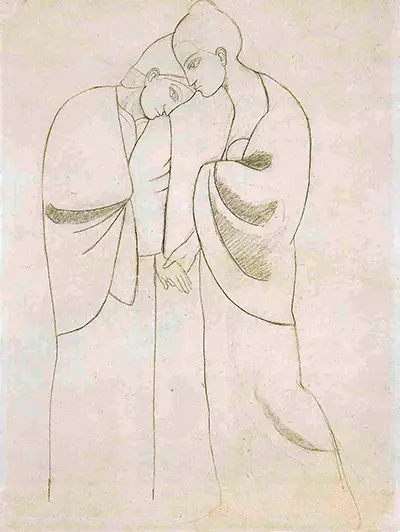The suicide of his close friend Carlos Casagemas had a major influence on Picasso as did the poverty he experienced at this time and saw around him. The resulting monochromatic works and the blue or blue-green heavy paintings were often sombre in tone, and included La Vie, Melancholy Woman and The Soup. Yet his work from this period has become some of his best loved today, although difficult to sell originally.
The drawing of the Two Sisters was influenced by Picasso's visit to a woman's prison at St Lazare in Paris where nuns acted as guards. In a letter to his friend and poet Max Jacobs in July 1902 he referred to the picture as that of a "St Lazare prostitute and a mother." Indeed the white bonnet seen to be worn by the woman on the left was compulsory for syphilitic prostitutes in St Lazare. Reality combines with Christian iconography as the pose of the picture suggests a visitation, with the blue of the final painting a symbol of Mary, the Mother of God.
It is difficult to relate the style of Picasso with other artists, but his work in the Blue Period, and especially the religious overtones as seen in A Study to Two Sisters, has been likened to Paul Gauguin. Both artists were brought up in Catholic households, and a fascination for faith and its practice continued in their work, even if not in their day to day lives. Picasso also admired Gauguin's depiction of the primitive nature of the human form.
Pablo Picasso had moved to the Madrid Royal Academy of San Fernando when just 18 years old, but found the singular focus on subject and technique stifling. From there he began to divide his time between Barcelona and Paris where he was to create his work of the Blue Period. A Study to Two Sisters was very emblematic of this period in themes of religiosity and the melancholy of the subjects and their scene.


